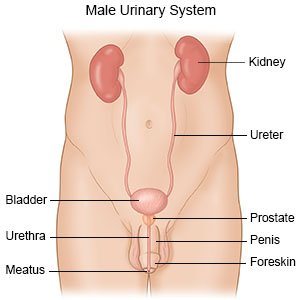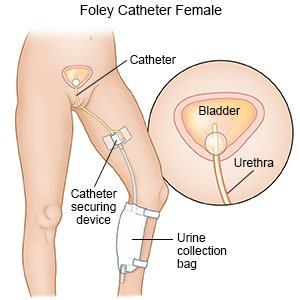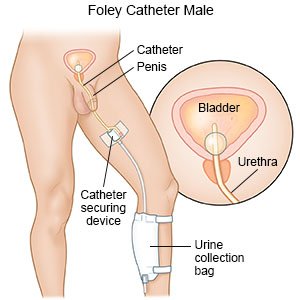Direct Visual Internal Urethrotomy
Medically reviewed by Drugs.com. Last updated on Aug 4, 2025.
AMBULATORY CARE:
What you need to know about a direct visual internal urethrotomy (DVIU):
A DVIU is surgery to widen a stricture (narrow area) in your urethra. The urethra is the tube that carries urine from your bladder out of your body. When the stricture is removed, you may be able to urinate more easily.
 |
 |
How to prepare for a DVIU:
- Your surgeon will tell you how to prepare. If you are having general anesthesia, your surgeon may tell you not to eat or drink after midnight before surgery. Arrange to have someone drive you home after you are discharged.
- Tell your surgeon about all medicines you currently take. He or she will tell you if you need to stop taking any medicine for surgery, and when to stop. Your surgeon will tell you which medicines to take or not take on the day of surgery.
- Tell your surgeon about all your allergies, including antibiotics and anesthesia.
- Practice Kegel exercises, and keep doing them even after surgery. These exercises squeeze your pelvic floor muscles and help them become stronger. Healthcare providers will teach you how to do Kegel exercises.
- You may need blood and urine tests before surgery. Urine tests are used to check for a urinary tract infection (UTI). The UTI will need to be treated with antibiotics before you have a DVIU. You may also need cystoscopy. A cystoscope is a tool used to check your urethra and bladder.
What will happen during a DVIU:
- Regional anesthesia may be used for this surgery. You may feel some pressure or pushing with regional anesthesia. You may also feel like you need to urinate during surgery. General anesthesia may instead be used to keep you asleep and free from pain during surgery.
- A camera will be put into your urethra and moved up to the stricture. Your surgeon will use a laser or cutting tool to widen the stricture. A Foley catheter will be placed into your bladder. The catheter moves urine from your bladder through your urethra.


- Your surgeon will use a cystoscope to check your bladder for problems created by the surgery. A cystoscope is a small tube with a light and magnifying camera on the end. Tools may be put through the cystoscope to treat any problems in your urethra or bladder.
What to expect after a DVIU:
- You may see small amounts of blood in your urine. This is normal. It is also normal to have an increased need to urinate. You may also have burning or mild discomfort when you urinate.
- Medicines may be given to prevent or treat pain or a bacterial infection.
- The Foley catheter may stay in for 3 to 5 days.
- You will be shown how to empty and replace the Foley catheter drainage bag.
Risks of a DVIU:
You may bleed more than expected or develop an infection. You may have pain when you urinate, or develop incontinence (trouble controlling your urine). Your urethra may be damaged. If you are a woman, a fistula may develop. This is an opening between your vagina and urethra. You will need surgery to correct a fistula. Even with surgery, you may have a stricture that continues or comes back. You may need other procedures if this happens.
Related medications
Seek care immediately if:
- You have blood or pus in your urine.
- You have severe pain in your lower abdomen or lower back.
- You have trouble urinating, or pain when you urinate.
Call your doctor or urologist if:
- You have a fever.
- You have pain in your lower abdomen.
- Your urine stays pink for longer than 1 day.
- You urinate less than usual, or still feel like you have to urinate after you use the bathroom.
- You have pain in the area between your anus and your genitals.
- You are male and have pain with an erection.
- You have pain during or after sex.
- You have questions or concerns about your condition or care.
Medicines:
You may need any of the following:
- Antibiotics help prevent or treat a bacterial infection.
- Prescription pain medicine may be given. Ask your healthcare provider how to take this medicine safely. Some prescription pain medicines contain acetaminophen. Do not take other medicines that contain acetaminophen without talking to your healthcare provider. Too much acetaminophen may cause liver damage. Prescription pain medicine may cause constipation. Ask your healthcare provider how to prevent or treat constipation.
- Take your medicine as directed. Contact your healthcare provider if you think your medicine is not helping or if you have side effects. Tell your provider if you are allergic to any medicine. Keep a list of the medicines, vitamins, and herbs you take. Include the amounts, and when and why you take them. Bring the list or the pill bottles to follow-up visits. Carry your medicine list with you in case of an emergency.
Self-care:
- Apply a warm, damp washcloth over your urethral opening. This may help if you have any discomfort.
- Ask your healthcare provider when it is okay to return your usual activities. He or she will tell you when you can drive, return to work, and do your normal activities. Ask when it is okay to have sex.
- Keep the Foley catheter bag below your waist. This will prevent urine from flowing back into your bladder and causing an infection or other problems. Keep the tube free of kinks so the urine will drain properly. Do not pull on the catheter. This can cause pain and bleeding, and may cause the catheter to come out. Your healthcare provider will remove the catheter as soon as possible.


- Drink liquids as directed. Liquids help prevent a urinary tract infection (UTI). Ask how much liquid to drink each day and which liquids are best for you.
- Do Kegel exercises. These exercises squeeze your pelvic floor muscles and help them become stronger.
- Do not apply pressure on your abdomen. Do not strain, lift heavy objects, or stand for long periods of time. Do not perform strenuous exercises, such as running or weightlifting. Your healthcare provider will tell you how long to be careful about pressure.
Empty your urine drainage bag
when it is ½ to ⅔ full, or every 8 hours. If you have a smaller leg bag, empty it every 3 to 4 hours. Do the following when you empty your urine drainage bag:
- Wash your hands with soap and water. Dry your hands with a clean towel or paper towel. Then put on a clean pair of medical gloves.

- Hold the urine bag over a toilet or large container. Remove the drain spout from its sleeve at the bottom of the urine bag. Do not touch the tip of the drain spout. Open the slide valve on the spout.
- Let the urine flow out of the urine bag into the toilet or container. Do not let the drainage tube touch anything.
- Clean the end of the drain spout with alcohol when the bag is empty. Ask which cleaning solution is best to use.
- Close the slide valve and put the drain spout into its sleeve at the bottom of the urine bag. Write down how much urine was in your bag if you were asked to keep a record.
- Change your urine bag or clean reusable bags. Ask how often you need to change or clean your urine drainage bag. You may need to change your reusable bag at least 1 time each week.
Follow up with your doctor or urologist as directed:
Write down your questions so you remember to ask them during your visits.
© Copyright Merative 2025 Information is for End User's use only and may not be sold, redistributed or otherwise used for commercial purposes.
The above information is an educational aid only. It is not intended as medical advice for individual conditions or treatments. Talk to your doctor, nurse or pharmacist before following any medical regimen to see if it is safe and effective for you.
Further information
Always consult your healthcare provider to ensure the information displayed on this page applies to your personal circumstances.
